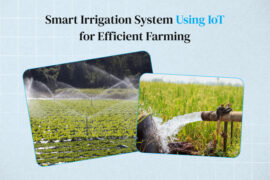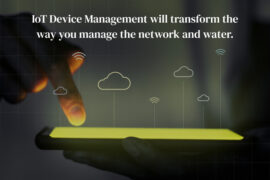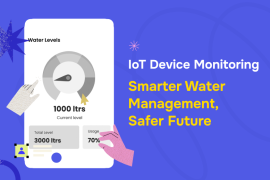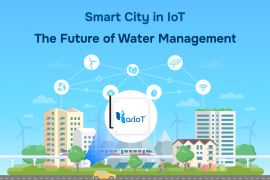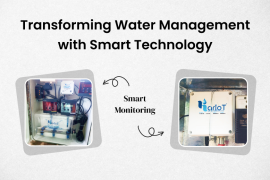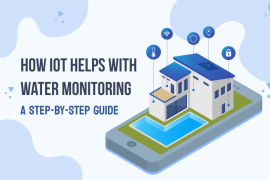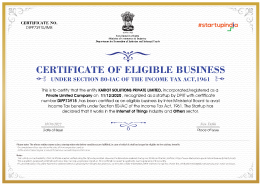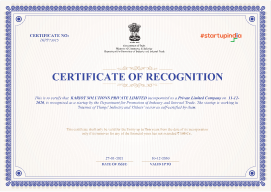Introduction:
At a time when not having enough water threatens the balance of our world, the new idea of smart water management using IoT shines like a beacon of hope. This innovative technology is more than just a tool; it’s a revolution that will help our water supplies last for a long time. This new idea has a “ripple effect” that changes all parts of our environment and marks the start of a new era in water management.
How to Use IoT for Smart Water Management:

Smart water management using IoT is a high tech process that uses the Internet of Things (IoT) to connect water management devices. Key parts like monitors, networks, and data analytics all work jointly to keep an eye on, study, and make smart preferences about using, distributing, and preserving water. This part goes into detail about how IoT has changed the way water is managed in the past.
When IoT technology is added to water management devices, they work better and respond faster. Using sensors spread out in the water system, real time data can be gathered and examined, giving useful information about how much water is used, where leaks are, and how well the system works overall. With this much tracking and control, it’s possible to take preventative steps like finding and fixing leaks or making the best use of water distribution based on demand.
Additionally, water managers can use the data gathered by IoT devices to create predictive models that aid in planning how much water will be required and maximising the use of their resources. This proactive method helps to keep water resources from running out, cut down on waste, and make sure they are used in a way that doesn’t harm the environment.
The Effects on the Environment:

This new technology will change the way we save water and keep ecosystems healthy. This part shows the good effects of smart water management using IoT by using case studies and real life examples. It also looks at how the technology will affect biodiversity, climate patterns, and human health in the long run, focusing on how it can help create a sustainable future.
By using IoT to apply smart water management, big environmental benefits can be brought about. Water conservation efforts can be directed more effectively. If accurate tracking of water use and the discovery of waste are used. This keeps natural ecosystems that rely on a steady water supply alive and well and also cuts down on water waste.
Also, IoT technology can protect water supplies from the impacts of climate change in significant ways. Water managers can plan for and react to changes in rainfall, droughts, and floods by keeping an eye on climate patterns and water levels all the time. By being proactive, we can make better plans and come up with better ways to adapt, which will make sure that water supplies are still available as the climate changes.
Problems and ways to fix them:

There are many benefits to using IoT for smart water management, but there are also some problems. That need to be solved, such as technical difficulties, a lack of funds, and rules that need to be followed. This part talks about these problems straight on and gives examples of creative and effective ways to solve them. Like new technologies, clear rules, and relationships between the government and citizens.
Using IoT to adopt smart water management is hard. Because it’s hard to figure out how to connect all the different devices and systems. But improvements in IoT technology, like standardized protocols and interoperability. Are making it easier for different devices in a water management system to join and be managed. Cloud computing and data analytics have also made it possible to process and study large amounts of data. This lets people make better decisions and improve the way water is managed.
Getting IoT devices and systems up and running can be expensive at first, which is another big problem. However, the long term advantages and cost savings that come with saving water and utilising it more often outweigh. The expenses incurred at the start. Public private partnerships and government incentives can also help ease the financial strain and encourage. The use of IoT for smart water management.
Concerns about data protection and regulatory issues must also be dealt with for this technology to be successfully implemented. To protect user privacy and make sure data is used responsibly. Clear regulations and instructions must be set for managing, storing, and transferring data. When government agencies, industry stakeholders, and research institutions work together. They can make entire regulatory frameworks that make it easier to use IoT in water management.

How IoT will change the future of smart water management:
Smart water management with the IoT has a bright future ahead of it. New developments and trends point to greater adaptability and compatibility with other smart technologies. This part tells stakeholders to imagine a world. Where technology and nature live together peacefully and urges them to invest in and get involved in this exciting field.
As IoT technology keeps getting better, smart water management will have a lot of options. Adding AI and machine learning algorithms. To IoT devices can make them even smarter by letting them make more accurate guesses and take action before something goes wrong. When IoT is combined with other smart technologies, like smart grids and smart cities. It can create a more complete way to handle water. Making better use of resources and making the whole system more efficient.
Also, for smart water management using IoT to become widely used, many groups must work together. These groups include water companies, government agencies, technology providers, and regular people. Technology and nature can work together in the future. If we put money into research and development, back policy frameworks, and spread knowledge and education.


